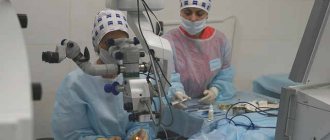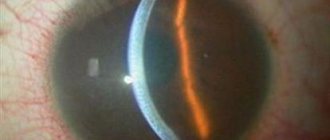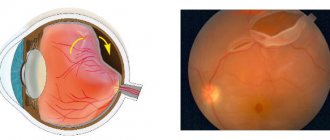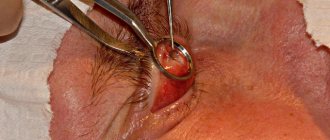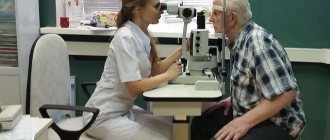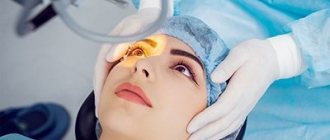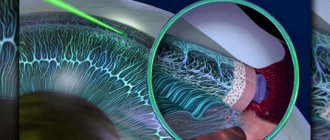Bruising and swelling after blepharoplasty are an absolutely natural and natural phenomenon. A bruise or hemorrhage is considered to be the penetration of blood from a damaged vessel into the thickness of the skin. Even such a simple operation as eyelid surgery still involves an incision, which means a small amount of soft tissue damage. Any violation of the integrity of the skin layers can be accompanied by damage to small blood vessels, which are located in a dense network. The body's response to injury is to attract plasma along with protective (immune) cells to the area of injury. This process, as well as disruption of microcirculation due to damage to small vascular branches, creates conditions for the appearance of postoperative edema.
Reasons and features of the appearance
As mentioned earlier, during any operation, vessels located in the working area are invariably injured. What kind of bruises will appear after blepharoplasty depends on the level of intervention and the volume of blood leaked under the skin. Blood loss can occur not only during the operation, but also after it.
Bruises do not always appear immediately after surgery - sometimes they can become visible only 1-2 days after the operation. The overall development and decline takes approximately 7-10 days. At the first stage, the bruises have a pronounced red color, then they lose their saturation and become more purple. Finally, they gradually acquire a yellowish-green color, which indicates the final stage of regeneration.
Swelling and hematomas disappear within a few days after surgery.
Answers to basic questions
When are the stitches removed?
On the first day, the woman/man is under the supervision of nurses and a doctor for 1–3 hours. The sutures are removed after 4–7 days. It all depends on the depth of the cut.
Will scars be visible on the eyelids?
Sutures are placed as close to the eyelash line as possible. After lower blepharoplasty they are almost invisible. After the end of the recovery period, they completely resolve.
After upper eyelid surgery, the sutures are more noticeable. They won't disappear in a month. It should take 12 weeks for the color to completely smooth out and even out. If scars remain after 3 months, physical therapy is performed to remove them.
When can you wear makeup after blepharoplasty?
Cosmetics can be applied 14 days after surgery. To avoid allergic reactions, since the skin is very sensitive during this period, select hypoallergenic cosmetics. Choose products from reliable brands recommended by your doctor.
Cosmetics should be light and soft. It is strictly forbidden to apply to the crust covering the surface of the wound, or to areas of irritation.
How long does it take to fully recover after blepharoplasty?
Takes 10–12 weeks. Photos of rehabilitation by day with explanations below.
A person can go home on the first day after the procedure. Severe swelling appears above and below the eyes, which can spread to the nose and area around the eyes.
2–3 days after the cosmetic procedure the swelling is slightly less. Take antiseptic drops and perform eye exercises.
A preventive examination is carried out on days 4–5. Contact lenses can be used.
On day 5, hematomas and swelling begin to subside. The skin under the patches itches. But you shouldn’t touch your eyes with your hands, much less scratch them.
6-7 days - the sutures are removed. The eye swells a little. The cyanosis disappears. Some sutures are self-dissolving, you need to come to an appointment.
On the 10th day, hemorrhages resolve. It is allowed to use cosmetics if the stitches dissolve.
After 2 weeks, the effect of the operation is almost invisible. The stitches are coming through.
40–45 days - recovery comes to an end. The effect of surgery remains noticeable.
By the end of 3 months, the sutures are completely dissolved.
What are the restrictions after blepharoplasty?
Blepharoplasty is a type of plastic surgery to correct cosmetic imperfections. 90% of success depends on the correct behavior of patients, so the following restrictions should be adhered to:
- sleep in a reclining position to prevent swelling;
- do not lift heavy objects or do bended work;
- eat as usual, avoid alcohol, smoking and spicy foods;
- do not wet the seams too much;
- do not remove the adhesive bandages yourself and do not pull out the threads;
- drink less fluid;
- give up contact optics for several months;
- do not visit the solarium, sauna and steam room;
- limit the consumption of coffee and tea;
- Do not use medications without prior consultation.
How long will the effect of blepharoplasty last?
Surgery of the upper and lower eyelids is characterized by good and lasting results. The duration of the effect depends on lifestyle.
Plastic surgeons claim that the result lasts up to 10 years, but practice shows that the effect lasts up to 5 years.
How long after you can have repeat blepharoplasty?
Repeated surgery is permitted if there are contraindications. Plastic surgeons do not recommend doing blepharoplasty more than 3 times in a lifetime.
Repeated surgery is performed after 3–4 months, when the initial sutures have completely healed.
How long do bruises last after blepharoplasty?
Hematomas become most severe during the first two days after surgery. After this period, the bruises gradually decrease. The amount and duration of recovery for each patient is determined individually. Sometimes bruises are localized on one side of the face - left or right. This is absolutely normal, although it happens less often.
The weakest bruises last two to three days. The most severe hematomas can persist for up to two weeks. Such periods are completely normal, and there is no need to panic and wonder what to do with bruises after blepharoplasty. Simply listen to your doctor and carefully follow all instructions he gives you to ensure a great aesthetic result.
What happens and how does swelling form?
Surgical lifts entail the destruction of soft tissue and the integrity of the skin. Such consequences are typical even after endoscopic surgery - just a few millimeter punctures are enough for a reaction to begin:
- increased permeability of arterial vessels - water comes out through the bloodstream, accumulating in the interstitial space;
- compression of the lumen of blood vessels and venous tissue - which prevents the outflow of blood and lymph;
- swelling - the more pronounced the initial period, the sooner the eyelid becomes swollen, and a longer period of resorption is required.
Excess water can also transfer to nearby areas, for example, to the cheekbone area.
On the lower eyelids
An edematous reaction is inevitable, only the degree of severity changes. The most intense swelling (up to the zygomatic area) occurs after classical surgery. Congestion is not as pronounced if it is transconjunctival blepharoplasty - fewer vessels are affected. The lower eyelid usually recovers within one week, although the patient's personal tolerance also matters.
On the upper eyelids
The dermis of this century is thin and more vulnerable. Swelling after blepharoplasty is usually almost unnoticeable, but it takes longer to go away because the area is less supplied with blood. To neutralize the side effect, use cold compresses.
Let us separately consider the situation when there is asymmetry of the eyes. This is possible in several cases.
- The patient was in a condition not directly related to fluid accumulation. This includes deterioration of muscle tone, unsynchronous healing, or other complications leading to asymmetry. Additional measures may be required, including repeat surgery.
- The degree of intervention was different for each eye. Where the hernia is more pronounced, it was necessary to remove additional excess skin. Accordingly, the swelling after blepharoplasty in the photo has become more noticeable.
What does it depend on?
As already mentioned, timing and quantity are purely individual characteristics. In general, several main factors can be identified that influence the appearance of bruises after blepharoplasty of the lower or upper eyelids:
- age category of the patient,
- skin type,
- volume and complexity of the operation,
- type of correction,
- technique.
For example, the older the patient, the longer it will take for dark circles under the eyes to go away after blepharoplasty. Thick skin will help reduce the visibility of hematomas, while thin skin, on the contrary, will lead to the fact that even the smallest hematomas will be clearly visible.
The operation itself is also important - how much tissue is removed? What type of access is used? This and much more directly affects the number of bruises that the patient will have after the intervention.
Complications due to physician error
Asymmetry of the eyelids
Asymmetry is a doctor's mistake. Sometimes the defect goes away on its own, in other cases additional surgical intervention is required. Formed due to overcorrection of the skin or improper suturing.
The doctor has removed too much tissue, so one eye may appear smaller than the other. The operation is inevitable.
Poor quality seams
Incorrect suture placement is not only an aesthetic defect, it leads to suture divergence.
Poor quality stitching material leads to rupture and infection. In such cases, re-suturing is required.
The infection occurs due to violations of sanitation standards and non-compliance with medical recommendations during the recovery period.
Folds on the eyelids
Skin folds are formed due to the removal of excess fat. The defect is removed by repeated surgery.
How to remove bruises after blepharoplasty?
It is within the patient's power to force tissue to regenerate faster. Therefore, proper care of the operated area is one of the key stages in the rehabilitation period. The first thing you need to do is follow all the doctor's instructions. To speed up the resorption of bruises, the doctor may prescribe treatment of the skin in the injured area with special preparations that ensure rapid resorption of the bruises. Remember that you cannot prescribe medications for yourself! Only the surgeon should prescribe what to apply to bruises after blepharoplasty.
The surgeon’s task is to select appropriate care products for the operated area, and the patient’s task is to follow all recommendations.
Applying cold, reducing the frequency of blinking and limiting computer work (as well as the use of other equipment, such as a TV or smartphone) will also help.
Rehabilitation
It is also important to follow a number of rules and prohibitions. For example, after surgery you should not sleep on your stomach with your face in the pillow. Sports activities and physical activity should be excluded. You are not allowed to visit the swimming pool, bathhouse or sauna. It is necessary to protect yourself from exposure to ultraviolet rays.
Of course, all these prohibitions apply only for the period of rehabilitation, and not for life. But nevertheless, observing the prohibitions is very important for a speedy recovery and elimination of bruises after blepharoplasty.
It is advisable to wear sunglasses at first. This stylish and, in addition, useful accessory, in addition to ultraviolet rays and bright lighting, will also protect your eyes from strong winds and dust particles.
When should you see a doctor?
How long it takes for bruises to go away after blepharoplasty is determined individually. On average, this period is about two weeks, depending on the severity, volume and depth of the bruises. But if the recovery takes longer, there is definitely no need to panic.
It is worth visiting a consultation with a surgeon if the hematomas last for a very long time, much longer than what the doctor stated. If external problems are accompanied by a deterioration in health (high body temperature, nausea, vomiting, pain in the eyes, decreased vision, profuse lacrimation even after several weeks, etc.) - in this case, a visit to your surgeon should not be postponed further than the next day.
How does the patient feel during rehabilitation?
After cosmetic surgery, operated patients experience dry eyes, burning, and soreness.
Almost immediately after the procedure, double vision appears. Diplopia is expressed in disruption of the motor muscles of the eye, which will gradually restore functioning. Soft tissue swelling is common in all patients who have undergone surgery.
Formed due to the integrity of soft tissues. In the affected area, vascular permeability increases, which leads to swelling.
Hematoma is a side effect common to all women. Appears in the first hours after the procedure and goes away within 2–3 days. Hematoma can be subcutaneous, tense, or retrobulbar.
Patients also complain of lacrimation, a feeling of a foreign body in the eye, and hyperemia. After the operation, vision may deteriorate slightly due to the ointment in the eye, the effect is temporary and disappears after 30 minutes.
